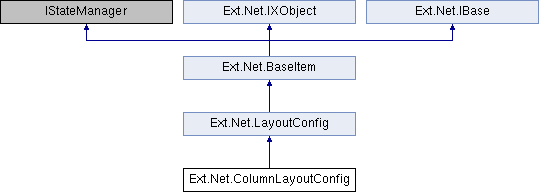This is the layout style of choice for creating structural layouts in a multi-column format where the width of each column can be specified as a percentage or fixed width, but the height is allowed to vary based on the content. This class is intended to be extended or created via the layout:'column' Ext.container.Container.layout config, and should generally not need to be created directly via the new keyword. More...

Public Member Functions | |
| ColumnLayoutConfig () | |
 Public Member Functions inherited from Ext.Net.LayoutConfig Public Member Functions inherited from Ext.Net.LayoutConfig | |
| LayoutConfig () | |
 Public Member Functions inherited from Ext.Net.BaseItem Public Member Functions inherited from Ext.Net.BaseItem | |
| virtual bool | HasExplicitValue (string name) |
| void | EnsureDataBind () |
| virtual void | Call (string name) |
| virtual void | Call (string name, params object[] args) |
| virtual void | AddScript (string script) |
| virtual void | AddScript (string script, params object[] args) |
| virtual bool | IsEmptyObject () |
| T | Apply< T > (IApply config) |
| BaseItem | Apply (object config) |
| virtual void | LoadViewState (object state) |
| virtual object | SaveViewState () |
| virtual void | TrackViewState () |
| void | SetDirty () |
| virtual void | DataBind () |
| virtual IControlBuilder | ToNativeBuilder () |
Properties | |
| override string | LayoutType [get] |
| override ConfigOptionsCollection | ConfigOptions [get] |
 Properties inherited from Ext.Net.LayoutConfig Properties inherited from Ext.Net.LayoutConfig | |
| virtual string | LayoutType [get] |
| virtual string | ItemCls [get, set] |
| An optional extra CSS class that will be added to the container. This can be useful for adding customized styles to the container or any of its children using standard CSS rules. See Ext.Component.ctCls also. More... | |
| virtual bool | ReserveScrollbar [get, set] |
| Set to true to leave space for a vertical scrollbar (if the OS shows space-consuming scrollbars) regardless of whether a scrollbar is needed. This is useful if content height changes during application usage, but you do not want the calculated width of child items to change when a scrollbar appears or disappears. The scrollbar will appear in the reserved space, and the calculated width of child Components will not change. More... | |
| override ConfigOptionsCollection | ConfigOptions [get] |
 Properties inherited from Ext.Net.BaseItem Properties inherited from Ext.Net.BaseItem | |
| virtual string | InstanceOf [get] |
| ItemState | State [get] |
| virtual DefaultValueMode | DefaultValueMode [get, set] |
| virtual bool | DesignMode [get] |
| bool | AutoDataBind [get, set] |
| ResourceManager | ResourceManager [get] |
| virtual Control | Owner [get, set] |
| The Owner Control for this Listener. More... | |
| virtual bool | IsDefault [get] |
| Does this object currently represent it's default state. More... | |
| bool | IsTrackingViewState [get] |
| EventHandlerList | Events [get] |
| EventHandler | DataBinding |
| Control?? | BindingContainer [get] |
| virtual ConfigItemCollection?? | CustomConfig [get] |
| Collection of custom js config More... | |
| virtual ConfigOptionsCollection | ConfigOptions [get] |
| virtual ConfigOptionsExtraction | ConfigOptionsExtraction [get] |
| System.Web.Mvc.HtmlHelper?? | HtmlHelper [get, set] |
 Properties inherited from Ext.Net.IXObject Properties inherited from Ext.Net.IXObject | |
| ConfigOptionsCollection | ConfigOptions [get] |
| ConfigOptionsExtraction | ConfigOptionsExtraction [get] |
| DefaultValueMode | DefaultValueMode [get, set] |
Additional Inherited Members | |
 Protected Member Functions inherited from Ext.Net.BaseItem Protected Member Functions inherited from Ext.Net.BaseItem | |
| BaseItem (Control owner) | |
| BaseItem () | |
| virtual void | OwnerUpdate (Control owner) |
| virtual void | OnDataBinding (EventArgs e) |
Detailed Description
This is the layout style of choice for creating structural layouts in a multi-column format where the width of each column can be specified as a percentage or fixed width, but the height is allowed to vary based on the content. This class is intended to be extended or created via the layout:'column' Ext.container.Container.layout config, and should generally not need to be created directly via the new keyword.
ColumnLayout does not have any direct config options (other than inherited ones), but it does support a specific config property of columnWidth that can be included in the config of any panel added to it. The layout will use the columnWidth (if present) or width of each panel during layout to determine how to size each panel. If width or columnWidth is not specified for a given panel, its width will default to the panel's width (or auto).
The width property is always evaluated as pixels, and must be a number greater than or equal to 1. The columnWidth property is always evaluated as a percentage, and must be a decimal value greater than 0 and less than 1 (e.g., .25).
The basic rules for specifying column widths are pretty simple. The logic makes two passes through the set of contained panels. During the first layout pass, all panels that either have a fixed width or none specified (auto) are skipped, but their widths are subtracted from the overall container width.
During the second pass, all panels with columnWidths are assigned pixel widths in proportion to their percentages based on the total remaining container width. In other words, percentage width panels are designed to fill the space left over by all the fixed-width and/or auto-width panels. Because of this, while you can specify any number of columns with different percentages, the columnWidths must always add up to 1 (or 100%) when added together, otherwise your layout may not render as expected.
Constructor & Destructor Documentation
◆ ColumnLayoutConfig()
|
inline |
Property Documentation
◆ ConfigOptions
|
get |
◆ LayoutType
|
getprotected |
The documentation for this class was generated from the following files:
- ColumnLayoutConfig.cs
- ColumnLayoutConfigConfigOptions.cs